1997 TOYOTA 4RUNNER ECU
[x] Cancel search: ECUPage 17 of 223
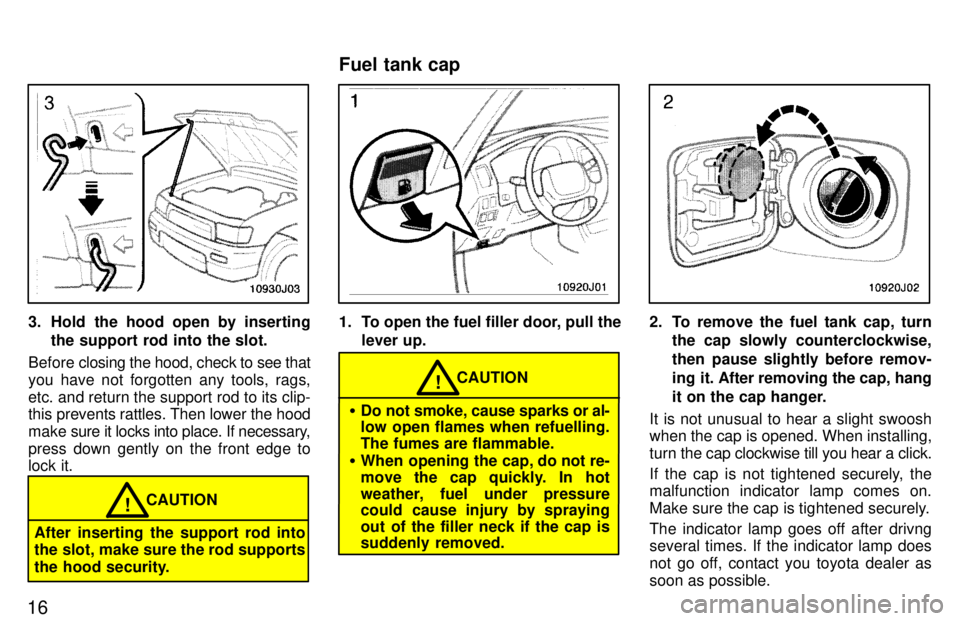
16
3. Hold the hood open by insertingthe support rod into the slot.
Before closing the hood, check to see that
you have not forgotten any tools, rags,
etc. and return the support rod to its clip-
this prevents rattles. Then lower the hood
make sure it locks into place. If necessary,
press down gently on the front edge to lock it.
CAUTION!
After inserting the support rod into
the slot, make sure the rod supports
the hood security.
1. To open the fuel filler door, pull the lever up.
CAUTION!
� Do not smoke, cause sparks or al-
low open flames when refuelling. The fumes are flammable.
� When opening the cap, do not re-
move the cap quickly. In hot
weather, fuel under pressure
could cause injury by spraying
out of the filler neck if the cap is
suddenly removed.
2. To remove the fuel tank cap, turn
the cap slowly counterclockwise,
then pause slightly before remov-
ing it. After removing the cap, hang
it on the cap hanger.
It is not unusual to hear a slight swoosh
when the cap is opened. When installing,
turn the cap clockwise till you hear a click.
If the cap is not tightened securely, the malfunction indicator lamp comes on.
Make sure the cap is tightened securely.
The indicator lamp goes off after drivng
several times. If the indicator lamp does
not go off, contact you toyota dealer as
soon as possible.
Fuel tank cap
Page 21 of 223
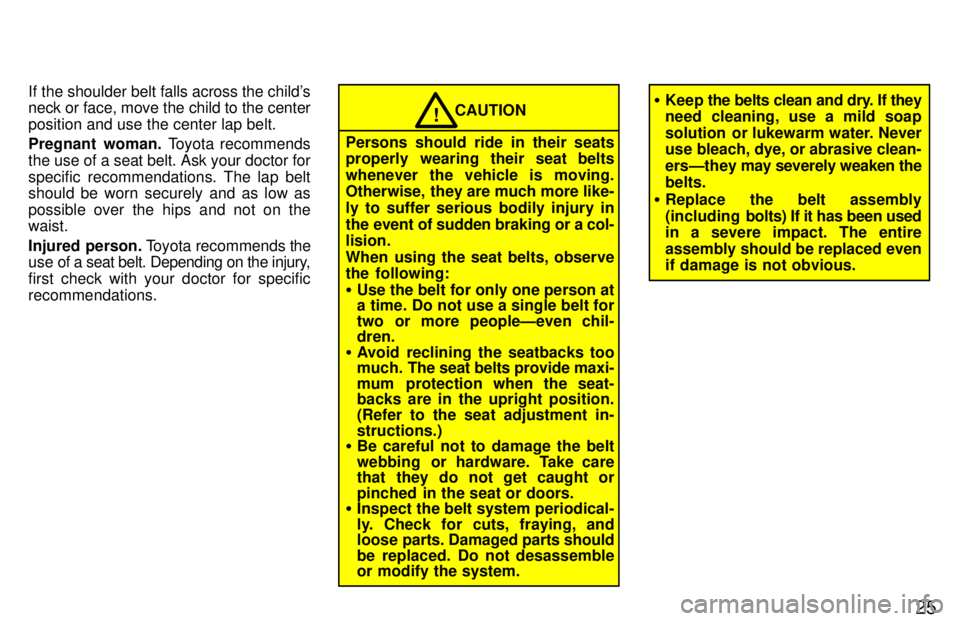
25
If the shoulder belt falls across the child's neck or face, move the child to the center
position and use the center lap belt.
Pregnant woman.
Toyota recommends
the use of a seat belt. Ask your doctor for
specific recommendations. The lap belt
should be worn securely and as low as
possible over the hips and not on the waist.
Injured person. Toyota recommends the
use of a seat belt. Depending on the injury,
first check with your doctor for specificrecommendations.
CAUTION!
Persons should ride in their seats
properly wearing their seat belts
whenever the vehicle is moving.
Otherwise, they are much more like-
ly to suffer serious bodily injury in
the event of sudden braking or a col- lision.
When using the seat belts, observe
the following: � Use the belt for only one person at
a time. Do not use a single belt for
two or more peopleÐeven chil- dren.
� Avoid reclining the seatbacks too
much. The seat belts provide maxi-
mum protection when the seat-backs are in the upright position.
(Refer to the seat adjustment in-structions.)
� Be careful not to damage the belt
webbing or hardware. Take care
that they do not get caught or
pinched in the seat or doors.
� Inspect the belt system periodical-
ly. Check for cuts, fraying, and
loose parts. Damaged parts should
be replaced. Do not desassemble
or modify the system.
� Keep the belts clean and dry. If they
need cleaning, use a mild soap
solution or lukewarm water. Never
use bleach, dye, or abrasive clean-
ersÐthey may severely weaken the
belts.
� Replace the belt assembly
(including bolts) If it has been used
in a severe impact. The entire
assembly should be replaced even
if damage is not obvious.
Page 22 of 223
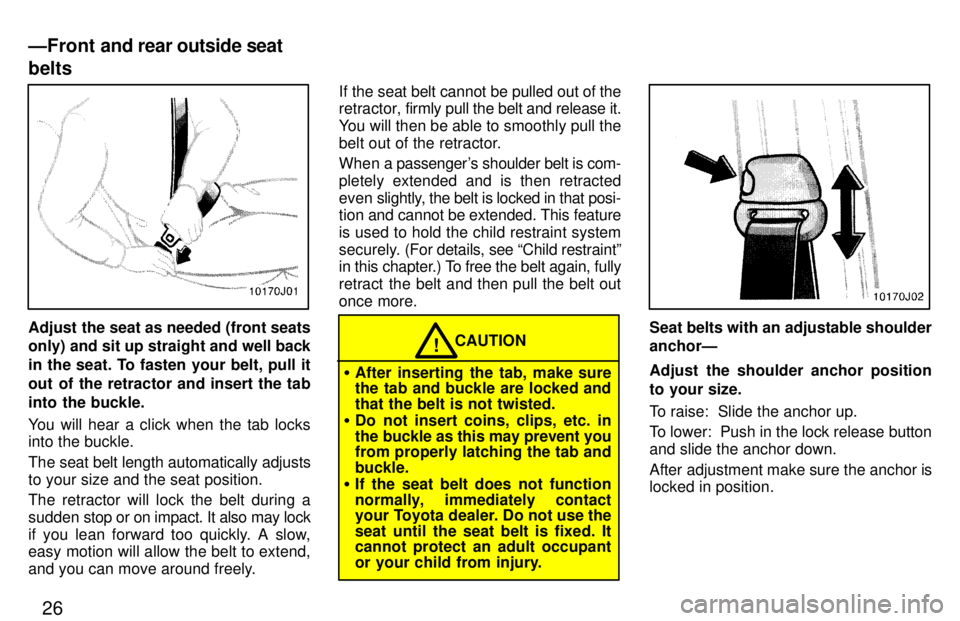
26
Adjust the seat as needed (front seats only) and sit up straight and well back
in the seat. To fasten your belt, pull it
out of the retractor and insert the tab
into the buckle.
You will hear a click when the tab locks into the buckle.
The seat belt length automatically adjusts
to your size and the seat position.
The retractor will lock the belt during a
sudden stop or on impact. It also may lock
if you lean forward too quickly. A slow, easy motion will allow the belt to extend,
and you can move around freely. If the seat belt cannot be pulled out of the
retractor,
firmly pull the belt and release it.
You will then be able to smoothly pull the
belt out of the retractor.
When a passenger's shoulder belt is com-
pletely extended and is then retracted
even slightly, the belt is locked in that posi-
tion and cannot be extended. This feature
is used to hold the child restraint system
securely. (For details, see Child restraintº
in this chapter.) To free the belt again, fully
retract the belt and then pull the belt out
once more.CAUTION!
� After inserting the tab, make sure
the tab and buckle are locked and that the belt is not twisted.
� Do not insert coins, clips, etc. in
the buckle as this may prevent you
from properly latching the tab and buckle.
� If the seat belt does not function
normally, immediately contact
your Toyota dealer. Do not use the
seat until the seat belt is fixed. It cannot protect an adult occupant
or your child from injury.
Seat belts with an adjustable shoulder anchorÐ
Adjust the shoulder anchor position
to your size.
To raise: Slide the anchor up.
To lower: Push in the lock release button
and slide the anchor down.
After adjustment make sure the anchor is
locked in position.
ÐFront
and rear outside seat
belts
Page 29 of 223

33
In a severe frontal impact, sensor detects
deceleration and the system triggers the
airbag inflator. Then a chemical reaction
in the inflator momentarily fills the airbags
with non-toxic nitrogen gas to help re-
strain the forward motion of the occu- pants. When the airbag inflates, they produce a fairly
loud noise and release some smoke
along with the nitrogen gas. This is notharmful and does not indicate a fire. Be
sure to wash off any residue as soon as
possible to prevent minor skin irritation.
Deployment of the airbags happens in a
fraction of a second, so the airbags must
inflate with considerable force. While the
system is designed to reduce serious inju-
ries, it may also cause minor burns or
abrasions and swellings.
Parts of the airbag module (steering
wheel hub, dashboard) may be hot for several minutes, but the airbags them- selves w ill not be hot. The airbags are de-
signed to inflate only once.
A crash severe enough to inflate the air-
bags may break the windshield as the ve-
hicle buckles. In vehicles with a passen-ger airbag the windshield may also be
damaged by absorbing some of the force
of the inflating airbag.
CAUTION!
� The SRS airbag system is de-
signed only as a supplement to
the primary protection of the driv-
er side aseat belt systems. The
driver is particularly susceptible
to death or serious injury if they
does not wear their seat belt;
when sudden braking or a colli-
sion occurs, they may be thrown
forward into the deploying SRS
aribag. To obtain a maximum
protection in an accident, the driv-
er and all passengers in the ve-
hicle should always wear their
seat belts when driving because
serious injuries can result to unre-
strained occupants. For instruc-
tions and precautions concerning
the seat belt system, see Seat
beltsº in this chapter.
� A baby or small child who is too
small to use a seat belt should be
properly secured in a rear seat us-
ing a child restraint system.
� Never use rear-facing child re-
straint system in the front seat be- cause the force of the rapid infla-
tion of the passenger airbag can cause severe injury to the child.
Page 32 of 223
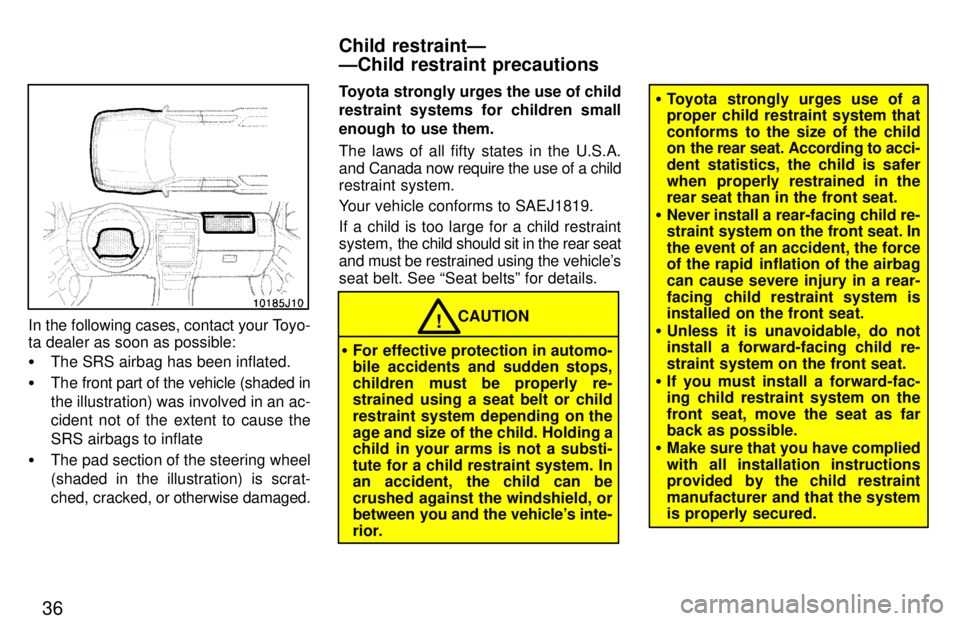
36
In the following cases, contact your Toyo-
ta dealer as soon as possible: �The SRS airbag has been inflated.
� The front part of the vehicle (shaded in the illustration) was involved in an ac-
cident not of the extent to cause the
SRS airbags to inflate
� The pad section of the steering wheel
(shaded in the illustration) is scrat-
ched, cracked, or otherwise damaged. Toyota strongly urges the use of child
restraint systems for children small
enough to use them.
The laws of all fifty states in the U.S.A.
and Canada now require the use of a child
restraint system.
Your vehicle conforms to SAEJ1819.
If a child is too large for a child restraint
system,
the child should sit in the rear seat
and must be restrained using the vehicle's
seat belt. See Seat beltsº for details.CAUTION!
� For effective protection in automo-
bile accidents and sudden stops,
children must be properly re-
strained using a seat belt or child
restraint system depending on the
age and size of the child. Holding a
child in your arms is not a substi-
tute for a child restraint system. In
an accident, the child can be
crushed against the windshield, or
between you and the vehicle's inte-
rior.
�Toyota strongly urges use of a
proper child restraint system that
conforms to the size of the child
on the rear seat. According to acci-
dent statistics, the child is safer
when properly restrained in the
rear seat than in the front seat.
� Never install a rear-facing child re-
straint system on the front seat. In
the event of an accident, the force
of the rapid inflation of the airbag can cause severe injury in a rear-
facing child restraint system is
installed on the front seat.
� Unless it is unavoidable, do not
install a forward-facing child re-
straint system on the front seat.
� If you must install a forward-fac-
ing child restraint system on the
front seat, move the seat as far back as possible.
� Make sure that you have complied
with all installation instructions
provided by the child restraint
manufacturer and that the system is properly secured.
Child restraintÐ ÐChild restraint precautions
Page 33 of 223
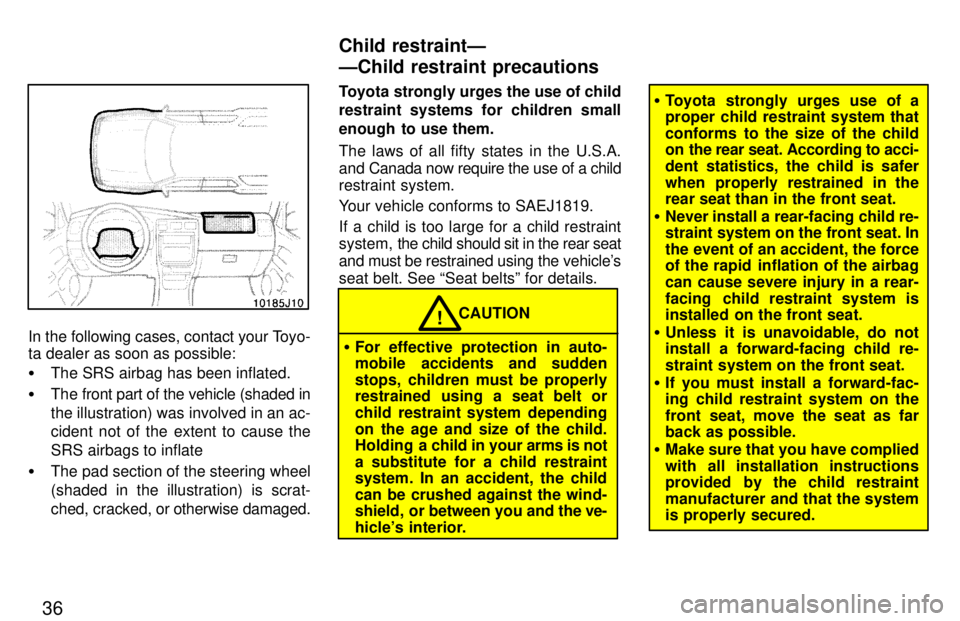
36
In the following cases, contact your Toyo-
ta dealer as soon as possible: �The SRS airbag has been inflated.
� The front part of the vehicle (shaded in the illustration) was involved in an ac-
cident not of the extent to cause the
SRS airbags to inflate
� The pad section of the steering wheel
(shaded in the illustration) is scrat-
ched, cracked, or otherwise damaged. Toyota strongly urges the use of child
restraint systems for children small
enough to use them.
The laws of all fifty states in the U.S.A.
and Canada now require the use of a child
restraint system.
Your vehicle conforms to SAEJ1819.
If a child is too large for a child restraint
system,
the child should sit in the rear seat
and must be restrained using the vehicle's
seat belt. See Seat beltsº for details.
CAUTION!
� For effective protection in auto-
mobile accidents and sudden
stops, children must be properly
restrained using a seat belt or
child restraint system depending
on the age and size of the child.
Holding a child in your arms is not
a substitute for a child restraintsystem. In an accident, the child
can be crushed against the wind-
shield, or between you and the ve-
hicle's interior.
� Toyota strongly urges use of a
proper child restraint system that
conforms to the size of the child
on the rear seat. According to acci-
dent statistics, the child is safer
when properly restrained in the
rear seat than in the front seat.
� Never install a rear-facing child re-
straint system on the front seat. In
the event of an accident, the force
of the rapid inflation of the airbag can cause severe injury in a rear-
facing child restraint system is
installed on the front seat.
� Unless it is unavoidable, do not
install a forward-facing child re-
straint system on the front seat.
� If you must install a forward-fac-
ing child restraint system on the
front seat, move the seat as far back as possible.
� Make sure that you have complied
with all installation instructions
provided by the child restraint
manufacturer and that the system is properly secured.
Child restraintÐ ÐChild restraint precautions
Page 34 of 223
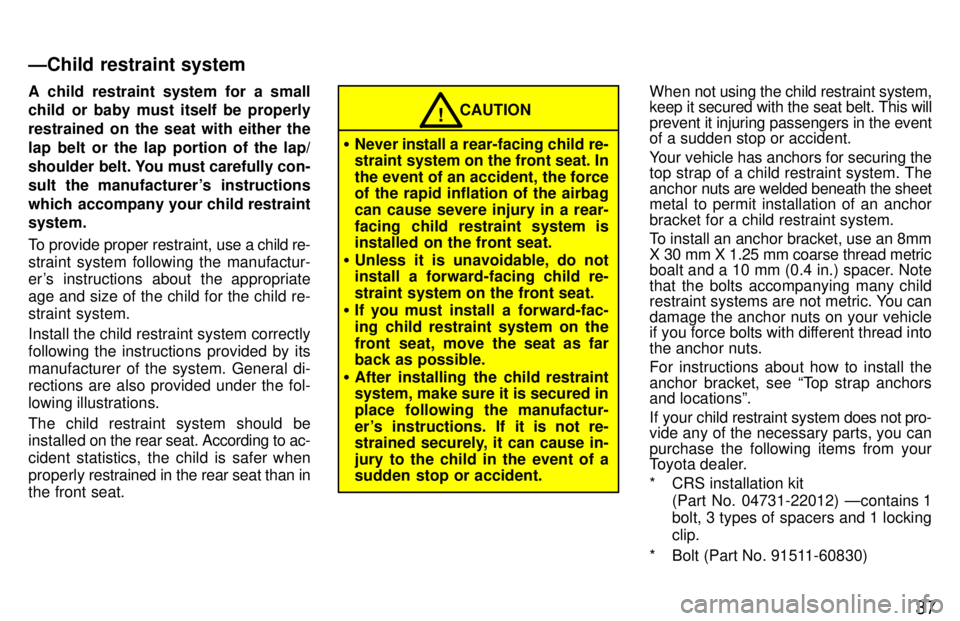
37
A child restraint system for a small
child or baby must itself be properly
restrained on the seat with either the
lap belt or the lap portion of the lap/
shoulder belt. You must carefully con-
sult the manufacturer's instructions
which accompany your child restraint system.
To provide proper restraint, use a
child re-
straint system following the manufactur-
er's instructions about the appropriate
age and size of the child for the child re-
straint system. Install the child restraint system correctly
following the instructions provided by its
manufacturer of the system. General di- rections are also provided under the fol-
lowing illustrations.
The child restraint system should be
installed on the rear seat. According to ac-
cident statistics, the child is safer when
properly restrained in the rear seat than in
the front seat.
CAUTION!
� Never install a rea r-facing child re-
straint system on the front seat. In
the event of an accident, the force
of the rapid inflation of the airbag can cause severe injury in a rear-
facing child restraint system is
installed on the front seat.
� Unless it is unavoidable, do not
install a forward-facing child re-
straint system on the front seat.
� If you must install a forward-fac-
ing child restraint system on the
front seat, move the seat as far back as possible.
� After installing the child restraintsystem, make sure it is secured in
place following the manufactur-
er's instructions. If it is not re-
strained securely, it can cause in-
jury to the child in the event of a
sudden stop or accident. When not using the child restraint system, keep it secured with the seat belt. This
will
prevent it injuring passengers in the event
of a sudden stop or accident.
Your vehicle has anchors for securing the
top strap of a child restraint system. The
anchor nuts are welded beneath the sheet
metal to permit installation of an anchor
bracket for a child restraint system.
To install an anchor bracket, use an 8mm
X 30 mm X 1.25 mm coarse thread metric
boalt and a 10 mm (0.4 in.) spacer. Note
that the bolts accompanying many child
restraint systems are not metric. You can
damage the anchor nuts on your vehicle
if you force bolts with different thread into the anchor nuts.
For instructions about how to install the
anchor bracket, see Top strap anchors
and locationsº.
If your child restraint system does not pro-
vide any of the necessary parts, you can
purchase the following items from your
Toyota dealer.
* CRS installation kit
(Part No. 04731-22012) Ðcontains 1
bolt, 3 types of spacers and 1 locking clip.
* Bolt (Part No. 91511-60830)
ÐChild restraint system
Page 37 of 223
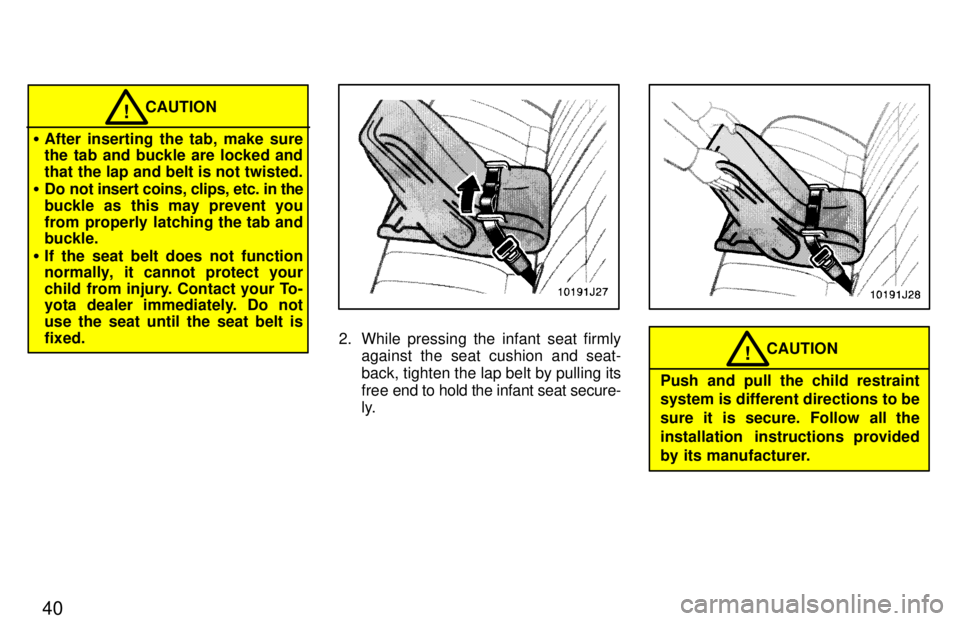
40
CAUTION!
� After inserting the tab, make sure
the tab and buckle are locked and
that the lap and belt is not twisted.
� Do not insert coins, clips, etc. in the
buckle as this may prevent you
from properly latching the tab and buckle.
� If the seat belt does not function
normally, it cannot protect your
child from injury. Contact your To-
yota dealer immediately. Do not
use the seat until the seat belt isfixed.
2. While pressing the infant seat firmly
against the seat cushion and seat-
back, tighten the lap belt by pulling its
free end to hold the infant seat secure-
ly.CAUTION!
Push and pull the child restraint
system is different directions to be
sure it is secure. Follow all the
installation instructions provided
by its manufacturer.